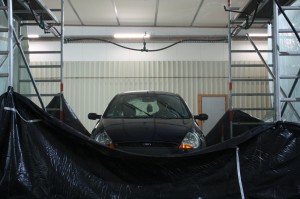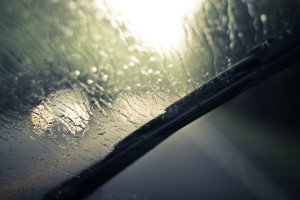German scientists plan to use moving vehicles to measure precipitation on rainy days, after noticing that drivers control the speed of their windshield wipers according to the intensity of rainfall—faster for heavy rain and slower for light rain or drizzle.
Writing in Hydrology and Earth System Sciences, the University of Hanover scientists say they will use cars equipped with GPS systems as mobile rain measuring devices.
The amount of rainfall can vary quite a bit within even small parts of a region. The scientists said that while standard rain gauges can provide accurate measurements, some parts of the world may have very few of these gauges in place and those they do have are spread out over a large area.
As a result, the measurements made by the rain gauges aren’t able provide the detailed information that would reflect that variation, information that could be vital to help predict and prevent flooding.
“If moving cars could be used to measure rainfall the network density could be improved dramatically,” said Uwe Haberlandt, project leader for the RainCars project, an initiative that was conceived after a brainstorming session between the scientists.
To test the idea, the researchers went to work in a laboratory equipped with a rain simulator that mimicked both light and heavy rainfall. They placed cars equipped with different types of windshield wiper systems, into their rain simulator to determine the relationship between wiper speed and rainfall intensity.
For their first experiment, they placed a person inside each of the cars to manually adjust the speed of the wipers for the best windshield visibility.
“The experiments have shown that the front visibility is a good indicator for rainfall intensity,” says Ehsan Rabiei, the paper’s lead author.
But the researchers also found that measurements made with this method might not be dependable since they would rely on the visibility perception of the individual making the manual wiper speed adjustments.
Moving on to their next rain simulator experiment, the researchers tested optical sensors used by some new wiper systems that allow the systems to operate automatically. These sensors use infrared laser beams that can detect rain drops collecting on the device’s surface. Each sensor reading, according to the researchers, corresponds to a specific amount of water – in other words, the more readings made by the sensors, the more intense the rainfall.
“The optical sensors measure the rain on the windshield in a more direct and continuous manner so, currently, they would be the better choice for rain sensors in cars,” said Haberlandt.
The researchers also found that speed isn’t the only factor that can impact rain measurements.

Here’s a car that’s being tested under the research group’s rain simulator (www.ikg.uni-hannover.de, Daniel Fitzner)
“Our experiments so far were carried out in an ideal and controlled environment. In nature there are external effects like wind, spray from other cars or shielding trees that can affect the readings, and rainfall characteristics are different from the rain simulator,” said Rabiei.
The research team’s goal isn’t so much about a higher accuracy of measuring rainfall, as it is about being able to increase the number of available measurement points.
A study published in 2010 by two members of the team showed that a system using a higher number of gauges that perhaps weren’t so accurate still provided more reliable rainfall readings than one that used a smaller number of much more accurate gauges.
The researchers said that they are already back at work conducting field experiments that use cars to measure the amount of real rainfall in and around their home city of Hanover.
They’re conducting these experiments with the help of volunteers, a taxi company and a car company, and say that they would like to see more people involved in this work.






















Comments are closed.